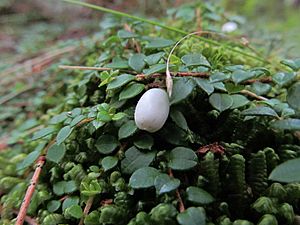Creeping snowberry facts for kids
Quick facts for kids Creeping snowberry |
|
|---|---|
 |
|
| Foliage and ripe fruit | |
| Scientific classification | |
| Genus: |
Gaultheria
|
| Species: |
hispidula
|
| Synonyms | |
|
Chiogenes hispidula |
|
The Gaultheria hispidula, often called the creeping snowberry or moxie-plum, is a small, spreading plant. It belongs to the heath family, Ericaceae. This plant grows close to the ground in North America. It produces tiny white berries that you can eat. These berries appear from August to September. Both its leaves and berries have a taste and smell like wintergreen.
Contents
About the Creeping Snowberry Plant
The creeping snowberry is an evergreen plant. This means it stays green all year. It's a type of prostrate shrub, which means it grows flat along the ground. It forms a thick mat of stems and leaves. This mat can spread up to 1 meter (3 feet) wide. But it only grows about 10 centimeters (4 inches) tall.
Its leaves are very small, less than 1 centimeter long. They grow one after another along the stems. In spring, you can see its pale green-white flowers. After the flowers, white berries grow in August and September. These berries are safe to eat and have a slightly sour taste.
Where Creeping Snowberries Grow
Creeping snowberries like to grow in acidic or neutral soils. You can find them in open woodlands and along the edges of forests. They especially like wet ground, such as in or near bogs. They often grow close to old tree stumps.
How They Get Pollinated
Different insects help pollinate the creeping snowberry. These include solitary bees, bumblebees, bee-flies, and hoverflies.
How Seeds Are Spread
Small animals help spread the seeds of this plant. Chipmunks and deer mice eat the berries. Then, they carry the seeds to new places.
Protecting the Creeping Snowberry
The creeping snowberry used to grow from far northern Canada all the way down to North Carolina. However, it has now disappeared from the southern parts of its original home. This is called being extirpated from an area.
Like many plants in North America, the creeping snowberry faces challenges. Cutting down forests (deforestation) is one problem. Another is competition from invasive plants. These are plants that are not native to the area and grow very fast. Some common invasive groundcovers, like English ivy or winter creeper, can take over the space where snowberries grow.
Because of these issues, the creeping snowberry is now rare in several states. For example, it is listed as endangered in Maryland and New Jersey. It is threatened in Rhode Island and rare in Pennsylvania. It is even thought to be completely gone from Ohio.
Despite these local problems, the plant is still quite common in Canada. So, its overall international status is considered secure. But deforestation and invasive plants continue to be big problems for all forest species in both Canada and the United States.
How People Use Creeping Snowberries
Native American peoples have used the creeping snowberry for a long time.
- The Algonquin people make a special drink from the leaves. This drink, called an infusion, helps them feel better if they have eaten too much. They also eat the fruit.
- People from Anticosti Island use the plant to help them relax.
- The Micmac people use a decoction (a strong liquid made by boiling the plant) from the leaves or the whole plant for different purposes.
- The Ojibwa people use the leaves to make a drink.
You can also cook the leaves and eat them like a vegetable. The fruits can be eaten fresh, baked, or used to make jam.
Images for kids


